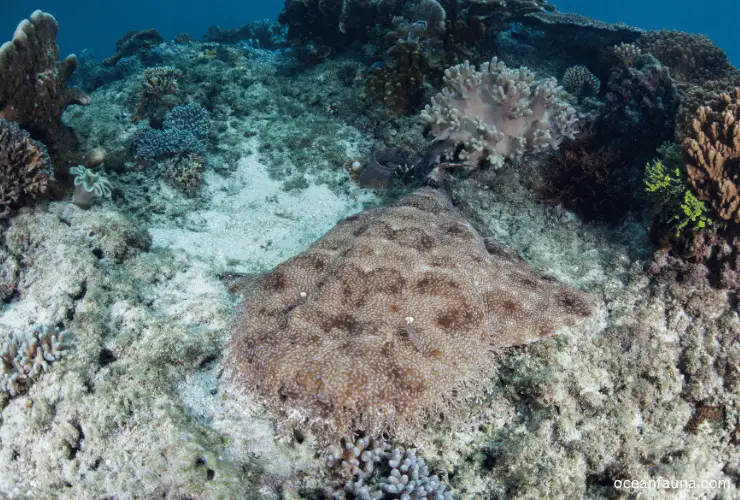The wobbegong are bottom-dwelling sharks living in the shallow waters of the western Pacific Ocean and the eastern Indian Ocean, mostly near Australia and Indonesia. However, one species is found as far north as Japan.
About this shark, there are so many questions in people’s minds. And in this article, I will try to answer as many of those questions as possible.
About Wobbegong Shark
The Wobbegong Shark is the common name of the 12 separate carpet shark species in the Orectolobidae family. This shark gets its name from its unique appearance, which resembles a shaggy carpet due to its flattened and elongated body shape as well as the numerous branch-like projections called dermal lobes that cover its skin.
The Wobbegong sharks are typically found in shallow, temperate waters along the continental shelves and rocky reefs and can grow up to 1.25 meters in length.
One of the most striking characteristics of this species is its ability to blend in seamlessly with its environment. It often lies motionless on the sea floor and waits for its prey, which includes smaller fish, crustaceans, and cephalopods.
Unlike many shark species, Wobbegongs have a unique suction feeding method, allowing them to catch prey with minimal movement. As their prey swims by, the shark opens its mouth and rapidly sucks in water, which pulls the prey into the shark’s mouth. This technique is so effective that Wobbegongs are known to capture prey that is the same size as they are.
Wobbegong Sharks are generally nocturnal and sleep most of their days on the ocean floor. They are typically solitary creatures, although they have been known to gather in small groups during the breeding season.
| Category | Information |
| Family | Orectolobidae |
| Order | Orectolobiformes |
| Length | 1.25 meters |
| Weight | Up to 25 kg (some may reach up to 50 kg) |
| Diet | Bony fishes, crustaceans, and cephalopods |
| Habitat | Coral and rocky reefs, seagrass beds, and sandy bottoms |
| Lifespan | Up to 25 years |
| Reproduction | Ovoviviparous |
| Gestation period | 10 to 11 months |
Anatomical Analysis: Wobbegong Shark
Here is a detailed anatomical analysis of the wobbegong shark.
Appearance
The Wobbegong Shark has a distinctive appearance: a flattened body, broad head, and large eyes. The skin is covered in dermal lobes, which makes it look like a carpet and helps it to blend into its surroundings. It has two dorsal fins, each with an upper lobe that can be twice as long as the lower lobe.
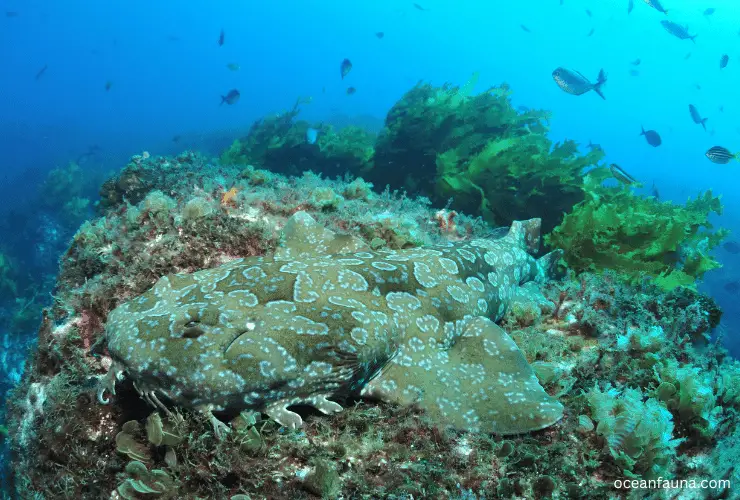
Integumentary System
The integumentary system comprises the skin and its associated structures, including scales, hairs, feathers, and glands. The skin of the Wobbegong Shark is tough and rough, containing placoid scales that are arranged in rows along the shark’s body.
These scales, also known as dermal denticles, help reduce drag and protect the shark against injuries and infections. The Wobbegong Shark’s skin is also covered in fleshy tassels, which are thought to provide camouflage and help the shark blend in with its surroundings.
Skeletal System
The skeletal system provides the structural support and protection for the Wobbegong Shark’s body, and it is primarily comprised of cartilage rather than bone. The shark’s skull is flattened and broad, which helps the shark crush its prey using its powerful jaws.
The Wobbegong Shark’s teeth are sharp and curved, with multiple rows of teeth-replacing the older ones as they fall out. The spinal column vertebrae are also flexible, allowing the Wobbegong Shark to change its shape and maneuver easily.
Muscular System
The muscular system of the Wobbegong Shark is powerful, allowing the shark to swim and hunt efficiently. The shark’s body contains both red and white muscles, with the red muscles providing sustained swimming power and the white muscles providing short bursts of speed for hunting.
The Wobbegong Shark’s jaw muscles are especially strong, enabling the shark to deliver a powerful bite to its prey.
Digestive System
The digestive system of the Wobbegong Shark is designed to consume a wide variety of prey. The shark’s mouth is on the underside of its body, allowing it to feed on prey hiding on the ocean floor.
The shark’s stomach is able to expand to accommodate larger meals, and its intestines are relatively short, allowing for quick digestion and absorption of nutrients.
What are the 12 species of Wobbegong Shark?
Here are the 12 species of Wobbegong Shark:
1. Spotted Wobbegong (Orectolobus maculatus) – The spotted wobbegong shark species is named for its distinctive pattern of dark spots on a light background. It has a broad head, large mouth, and strong jaws, making it a skilled predator.
2. Ornate Wobbegong (Orectolobus ornatus) – This ornate wobbegong shark has a mottled coloration and a heavily fringed appearance. It is an ambush predator that uses its ornate appearance to blend in with the reef.
3. Tasselled Wobbegong (Eucrossorhinus dasypogon) – The tasselled wobbegong shark has long, tasseled lobes above its eyes. It is known for its aggressive behavior and has been known to bite humans who get too close.
4. Western Wobbegong (Orectolobus Hutchins) – The western wobbegong shark is sometimes called the Western Wobbegong and is found off the coast of Western Australia. It has a rounded snout and a mottled coloration that helps it blend in with the reef.
5. Japanese Wobbegong (Orectolobus japonicus) – As its name suggests, the Japanese wobbegong species is found in Japan and has a distinctive pattern of light markings on a dark background. It is often caught for its meat and is considered a delicacy in Japan.
6. Floral Banded Wobbegong (Orectolobus floridus) – The Floral Banded Wobbegong shark has a distinctive pattern of dark bands on a light background, resembling flowers. It has a broad head and strong jaws and is known to be an opportunistic feeder.
7. Dwarf Spotted Wobbegong (Orectolobus parvimaculatus) – This small species is found in shallow waters around Australia and Indonesia. It has a distinctive coloration of small spots and a lighter underside.
8. Northern Wobbegong (Orectolobus wardi) – The northern wobbegong species is found in northern Australia and Papua New Guinea waters. It has a mottled coloration and a broad, flattened appearance.
9. Network Wobbegong (Orectolobus reticulatus)– This shark has a distinctive pattern resembling a network of lines. It is found in the waters of northern Australia and southeast Asia.
10. Indonesian Wobbegong (Orectolobus leptolineatus) – This shark is found in the waters of Indonesia and has a long, slender appearance. It is sometimes referred to as the slender wobbegong.
11. Cobbler Wobbegong (Sutorectus tentaculatus) – The cobbler wobbegong species has a flattened appearance and long, branched appendages around its mouth. It is found in the waters of northern Australia and is known for its aggressive behavior.
12. Gulf Wobbegong (Orectolobus halei) – The shark with a mottled coloration and a broad head is well-suited for ambush predation. It can be found in the Gulf of Carpentaria along the coast of Australia.
What Do Wobbegong Sharks Eat?
The wobbegong shark has a diverse diet primarily consists of fish such as bass, parole, rays, and scorpionfish. In addition to these fish, it also consumes invertebrates like crabs, lobsters, and octopi.
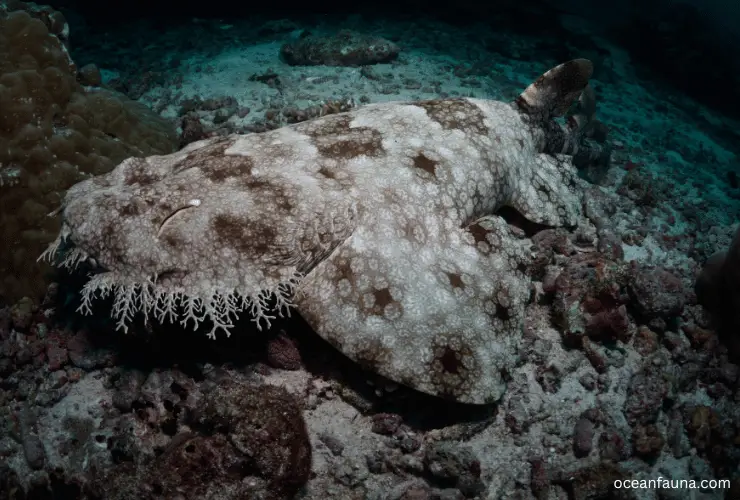
One of the unique characteristics of this shark is its ability to camouflage itself in the sand on the ocean floor, lying in wait for potential prey to pass by. Once a suitable target is spotted, the wobbegong shark sucks up its prey with a swift burst of suction.
The technique used by the wobbegong shark to capture prey is known as buccal suction feeding. This powerful suction is created by the shark’s large and specialized jaws, allowing it to quickly engulf prey without chasing or biting.
In addition to the strength of its jaws, the wobbegong shark also has sharp teeth that allow it to efficiently tear apart its prey into smaller, more manageable pieces.
Overall, the wobbegong shark is a highly adaptable predator with a versatile diet that allows it to thrive in various marine ecosystems. Its unique approach to hunting and feeding and impressive physical adaptations make it a fascinating species to study and observe in its natural habitat.
Where Do Wobbegong Sharks Live?
Although I discussed the habitat of the 12 species of wobbegong sharks above, here is a brief. The wobbegong shark is mainly found in coastal and shallow waters around coral reefs and rocky areas. It can be found throughout the Indo-Pacific Ocean, from South Africa to Indonesia, Japan, New Zealand, and Australia.
One of the most common species is the tasseled wobbegong, which is found in the shallow waters of the Indo-Pacific region, from the coast of Japan to northern Australia.
Another species of wobbegong shark is the spotted wobbegong, found in the temperate waters along the southern coast of Australia. The dwarf wobbegong is found in tropical waters, including the Great Barrier Reef in Australia and around islands in the Indian and Pacific Oceans.
Overall, wobbegong sharks are typically found in shallow waters, from intertidal zones to depths of about 100 meters. They prefer rocky reefs, coral reefs, and kelp forests, where they can hide and ambush their prey, typically small fish and crustaceans.
Lifespan Of Wobbegong Shark
The wobbegong shark, a unique species widespread throughout the Indo-Pacific waters, is known for its impressive lifespan. The scientific community estimates that wobbegongs can live up to 25 years in the wild, which makes them one of the longest-lived shark species.
However, the lifespan can vary according to various environmental factors, such as habitat, food availability, disease, and predation.
Wobbegongs have several adaptations that contribute to their long life expectancy. They have a slow growth rate, which means they don’t reach maturity until they’re around 6 to 11 years old, depending on the species. This slow growth strategy is thought to provide a selective advantage by reducing early mortality rates and increasing the chances for successful reproduction in old age.
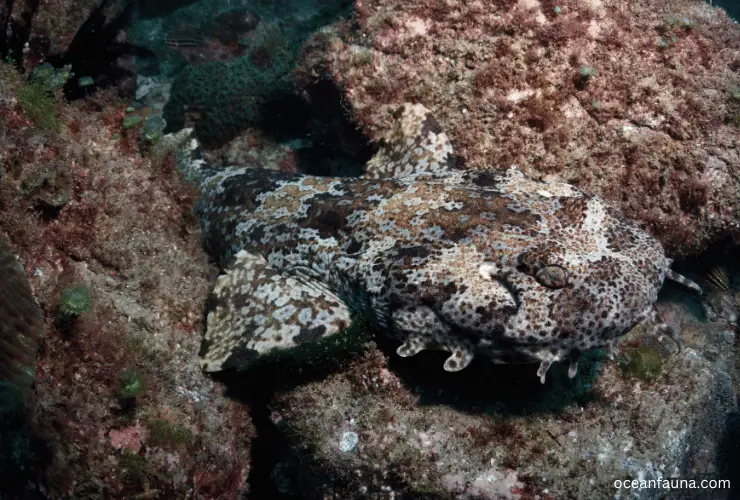
Another factor contributing to wobbegong longevity is their sedentary lifestyle and cryptic behavior. They spend considerable time motionless on the sea floor, perfectly camouflaged among the rocks and reefs, waiting for prey to come close. This low-energy lifestyle reduces their metabolic rate and minimizes the risk of injury or exhaustion, which can lead to premature death.
Interestingly, wobbegongs have survived serious injuries and even dismemberment, thanks to their remarkable capacity for regenerating body parts. If they lose a fin or a tail in a fight, they can regrow it over time, just like lizards regrow their tails.
It’s worth noting that some species of wobbegong live longer than others. For example, the spotted wobbegong (Orectolobus maculatus) can live up to 25 years, while the dwarf wobbegong (Orectolobus parvimaculatus) has a maximum lifespan of around 15 years.
Other factors, such as human fishing and habitat loss, can also affect the longevity of wobbegongs and threaten their survival.
How Does Wobbegong Shark Reproduce?
Female wobbegong sharks employ an ovoviviparous reproductive strategy, which involves the production of eggs that are retained within the female’s body until the embryos are fully developed, and then subsequently give birth to live young.
This reproduction method is commonly known as “giving birth to live young” and allows the female to protect and nurture her offspring within her body until they are fully developed and can survive on their own.
While the gestation period for wobbegong sharks is somewhat prolonged, taking around 10 to 11 months, they demonstrate relatively low fecundity. In fact, the species practices a triennial breeding cycle, meaning that females only give birth to a single litter once every three years.
Therefore, despite the considerable number of pups (potentially as many as 20 in one litter) produced during each reproductive event, wobbegong sharks have relatively low reproductive output compared to other species of sharks.
During reproduction, male wobbegong sharks will seek out females and engage in courtship behaviors to stimulate females to mate. After mating occurs, the female shark will retain fertilized eggs within her oviducts for the entire gestation period.
While the eggs are within her body, female wobbegong sharks receive no parental care from the male and are solely responsible for incubating and nourishing the developing embryos.
Are Wobbegong Sharks Dangerous?
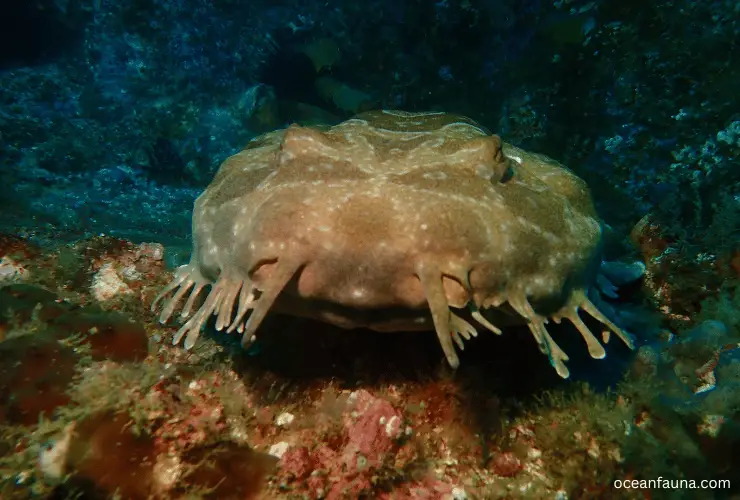
Wobbegong sharks are not generally considered dangerous to humans. However, there have been instances where they have attacked swimmers, snorkelers, and scuba divers who have come too close to them or accidentally stepped on them. These situations have led to mild to moderate injuries, but fatalities due to wobbegong shark attacks are rare.
Remember, wobbegong sharks have sharp teeth and strong jaws that can easily bite through a wetsuit or skin. Thus, avoiding them and maintaining a safe distance when in their natural habitat is best.
Wobbegongs are bottom-dwelling sharks that camouflage well with their surroundings, making them difficult to spot. Therefore, staying alert and cautious while snorkeling or swimming in areas where they are commonly found is recommended.
In addition, wobbegong sharks are nocturnal creatures, meaning they are most active during night hours. Diving or swimming during these times may increase the likelihood of encountering these sharks.
However, remember that shark attacks are rare, and wobbegong sharks prefer avoiding human interaction. Humans and wobbegong sharks can coexist peacefully with appropriate precautions and respect for their natural habitat.
What Is The Conservation Status Of Wobbegong Shark?
The conservation status of the wobbegong shark varies among different species. Have a look to the chart first-
| Species name | Conservation status |
| Spotted wobbegong | Least Concern |
| Ornate wobbegong | Least Concern |
| Tasselled wobbegong | Least Concern |
| Western wobbegong | Least Concern |
| Japanese wobbegong | Decreasing day by day (Least Concern) |
| Floral banded wobbegong | Least Concern |
| Dwarf spotted wobbegong | Least Concern |
| Northern wobbegong | Least Concern |
| Network wobbegong | Data Deficient |
| Indonesian wobbegong | Near Threatened |
| Cobbler wobbegong | Least Concern |
| Gulf wobbegong | Fully Recovered (previously as per data of 2015, Least Concern) |
This chart is made as per the data of IUCN Red List-
From the chart you can see, the spotted wobbegong, ornate wobbegong, tasseled wobbegong, western wobbegong, floral banded wobbegong, dwarf spotted wobbegong, northern wobbegong, and cobbler wobbegong are all classified as “Least Concern” by the International Union for Conservation of Nature (IUCN) Red List. This means that their populations are stable and not in danger of extinction.
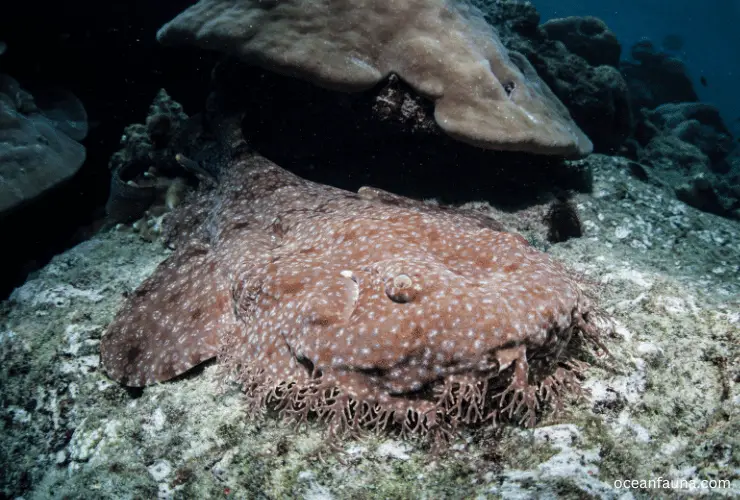
However, the Japanese wobbegong is currently experiencing a decreasing population, despite having a “Least Concern” status. This indicates that its conservation status may need to be reassessed in the future to ensure the preservation of the species.
The conservation status of the network wobbegong is currently “Data Deficient,” meaning that there is not enough information available to assess its population status and potential threats. Further research is needed to accurately determine the conservation status of this species.
The Indonesian wobbegong is currently classified as “Near Threatened,” which means that its population is at risk of becoming endangered in the future. This is likely due to habitat loss and overfishing in the species’ range.
The Gulf wobbegong has shown a positive trend in recovery, having fully recovered by 2021, despite having a “Least Concern” status in 2015. This can be attributed to successful conservation efforts and implementation of sustainable fishing practices in the area.
Overall, while most wobbegong shark species have a “Least Concern” status, monitoring their populations and potential threats is important to ensure their long-term survival. Conservation efforts, such as habitat protection and sustainable fishing practices, can play a vital role in preserving these unique and valuable species.
Which Conservational Efforts are Taken to Save Wobbegong Sharks
Unfortunately, the population of wobbegong sharks has suffered from overfishing, habitat destruction, and other human activities. Therefore, several conservational efforts have been taken to save wobbegong sharks.
Establishing marine protected areas (MPAs) is one of the most crucial measures. MPAs are areas where fishing and other human activities are restricted, allowing species to thrive and recover. In Australia, wobbegong sharks are protected in several MPAs, such as the Jervis Bay Marine Park, Sydney Harbour, and the Great Barrier Reef Marine Park.
Another critical effort is implementing sustainable fishing practices. Wobbegong sharks are often caught accidentally in commercial fishing nets, and their meat and fins are sold on the black market.
Fishing regulations have been introduced to reduce these impacts, emphasizing the importance of catch limits, fishing gear modifications, and reporting accidental catches.
Furthermore, education and outreach programs are essential to raising awareness about the importance of wobbegong sharks and their role in the ecosystem. For example, in Australia, the Taronga Zoo has an exhibit dedicated to wobbegong sharks, where visitors can learn about their behavior, biology, and conservation.
Finally, research and monitoring programs are essential to gather data on wobbegong shark populations and their habitats. This information can help policymakers make informed decisions about conservation efforts and identify areas that require greater protection.
FAQs
What do spotted wobbegong sharks eat?
The Spotted Wobbegong is a type of shark that hunts at night by staying still on the seabed and waiting for prey to pass by. They have a diverse diet and eat various species, such as fish, crayfish, crabs, and octopuses.
Do wobbegong sharks have teeth?
Yes, wobbegong sharks have well-developed teeth. They have sharp, serrated teeth for grasping and tearing prey such as fish, squid, crabs, and lobsters. The size of their teeth depends on the species, with some having smaller teeth than others.
What is the largest wobbegong shark?
The largest wobbegong shark would be the Spotted Wobbegong and the Banded Wobbegong, both of which reach about 3 meters (9.8 feet) in length. These two species of wobbegong sharks are considered to be the giants of the wobbegong family and are known for their distinctive markings and patterns, which help them blend into their surroundings and avoid detection by predators and prey.
Conclusion
Hopefully, now you have an in-depth knowledge of wobbegong sharks. I have tried to discuss all the important aspects of wobbegong sharks, from their biology to how we can conserve them. Wobbegong sharks are a unique and valuable species that must be protected, so conservation efforts must continue to ensure their long-term survival. If you have any further queries, please feel free to ask in a comment. I will answer them as soon as I can.

